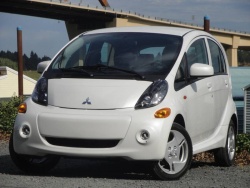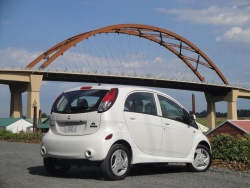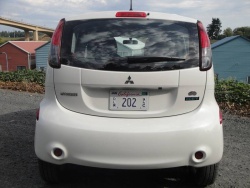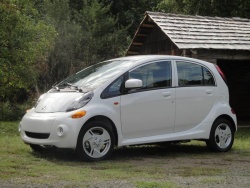 2012 Mitsubishi iMiev. Click image to enlarge |
|
More Mitsubishi iMiev reviews on Autos.ca
Manufacturer’s web site |
Review and photos by Greg Wilson
Photo Gallery:
2012 Mitsubishi iMiev
Portland, Oregon – Until recently, the promise of mass-produced electric cars from major vehicle manufacturers has always seemed like a distant goal, often delayed and extended to some future time. Now with the new Nissan Leaf, Chevrolet Volt, Tesla Roadster, and Mitsubishi iMiev (pronounced i-Meev) on sale to the public in Canada (although still in limited numbers in limited locations), and many more on the way, there is a real sense that the second coming of the electric car is finally here.
Of course, just because they’re available, doesn’t mean people will buy them. Early adopters and well-to-do trendsetters will snap up the first electric cars on the market, but mass-market consumers are naturally skeptical about new technology: there’s been plenty of criticism of electric cars’ limited driving range, high initial prices, and the lack of public recharging stations. Realistically, electric cars have a long way to go before they can compete with traditional vehicles on price, range and convenience. Still, it’s likely that their high initial start-up costs and limited technology will improve with mass production and real-world experience.
  2012 Mitsubishi iMiev. Click image to enlarge |
In fact, there have already been improvements in electric cars: when we previewed the Japanese version of the iMiev last year which has been on sale in Japan since 2009, we found it to be an ideal urban car with room for four adults, but its maximum driving range of 120 km, and even less if driven aggressively with electricity-depleting accessories like the air conditioner or heater turned on, limited its usefulness. And its retail price in Japan was approximately CAN$49,000, a lot of money for a subcompact car.
Compare that with the new-for-North-America 2012 Mitsubishi iMiev which has a maximum of driving range of 155 km and is 110 mm (4.3 in.) wider than the Japanese and European iMievs with correspondingly more passenger and cargo space, and improved handling and stability. It starts at $32,998 – still a lot of money for a subcompact car, but less than the original iMiev.
The iMiev’s 330-volt lithium-ion battery pack, 49 kW/66 hp electric motor, onboard charger, and DC converter are hidden under the floor, over the rear wheels, and under the trunk floor between the frame rails for crash protection (in case of a collision, the battery automatically shuts down). This arrangement allows the iMiev to have a long wheelbase with minimal front and rear overhangs, and lowers the centre of gravity for better handling and stability. For such a tall vehicle (1615 mm/63.6 in.), we found that the iMiev leans very little when cornering briskly, and its handling seems mainly hindered by its skinny, low rolling-resistance Dunlop Enasave 175/50R 15-inch tires. To help keep the shiny side up, all iMievs include the latest safety nannies: electronic traction and stability control, anti-lock brakes and emergency brake assist, brake override (if both accelerator and brake pedal are depressed), and tire pressure monitoring system.
 2012 Mitsubishi iMiev. Click image to enlarge |
Mitsubishi cites a 0 to 80 km/h time of 10.6 seconds for the iMiev but didn’t supply us with the more traditional 0 to 100 km/h time for comparison with conventional vehicles, probably because the iMiev would look rather slow. But as an urban car, zero to 100 km/h times are less relevant than zero to 50 km/h times: the iMiev is arguably quicker from a stop light than many cars because 100 per cent of its electric motor’s torque (145 lb.-ft.) is developed right from initial throttle at 0 rpm. The iMiev is perky and responsive around town, and eerily quiet.
On the highway, the iMiev cruises along nicely and has a maximum speed of 130 km/h, but seems to suck back the power at higher speeds, especially going uphill! Regenerative braking recharges the battery when going downhill or braking and the brake pedal needs very little pressure to stop the car. Though Mitsubishi cites a maximum range is 155 km, the U.S. EPA rates its range at only 100 km (in a mix of 55 per cent city/45 per cent highway driving).
 2012 Mitsubishi iMiev. Click image to enlarge |
An interesting feature of the iMiev is a noise-maker mounted in the front of the car to alert pedestrians to the approach of the otherwise-silent iMiev. It operates between 3 and 30 km/h with a sound akin to an electrical whine; after that the sound of the electrical motor is loud enough to perform the same function. We found the noise-maker very difficult to hear, particularly if there were other traffic noises around – and we couldn’t hear it behind the car when reversing. Mitsubishi might have to turn up the volume a bit.
The iMiev has three driver-selectable Drive modes: Drive mode which provides full power and standard regenerative charging when braking and coasting; Eco mode which reduces the power available but increases regenerative braking; and Brake mode which offers full power but the strongest regenerative braking.
We found Drive mode to be the most suitable for city and highway driving. It offers the best throttle response and the least drag from the regenerative brakes. Eco mode makes the iMiev sluggish under acceleration and adds drag when braking and coasting, but this mode will give you a longer driving range and is best used when cruising on the highway; Brake mode is a weird combination of full power and strong drag when braking and decelerating. However, if the battery is low on power, this is the best mode to be in because it offers the maximum charging while driving.
   2012 Mitsubishi iMiev. Click image to enlarge |
The driver can watch how economical their driving style is on the real-time battery charging gauge (Eco-meter) in the instrument cluster. It indicates when the battery is being charged (blue), when the battery is using minimal power (green), and when maximum power is being drawn (grey and white). As well, a small “fuel” gauge on the left shows how much charge is left in the battery.
There are actually two batteries in the iMiev: the main 330-volt lithium-ion battery powers the electric motor, air conditioning and heater, power brakes and power steering. All other accessories – wipers, power windows, power locks, radio, defroster, and optional navigation system – run off the standard 12-volt battery.
The lithium-ion battery can be charged three ways: using 120-volt, 8-amp household power, it take 22.5 hours to charge the battery from zero to full charge; using 240-volt, 15-amp power, it takes 7 hours to fully charge. With a DC quick charger, such as the ones available at a limited number of charging systems in Canada, the iMiev can be charged to 80 per cent capacity in 30 minutes.
A 120-volt charging cord is included with the price of the iMiev, but 240-volt cords must be purchased separately. These plug into the rear passenger side of the vehicle. The DC quick-charger plug is located on the front driver’s side.
Obviously, charging the iMiev using 120-volt household current is impractical if you drive it everyday and want to charge the car overnight. However, if you have a house or townhouse, a 240-volt charging system can be installed in your home or garage at your expense (approximately $1,500 to $2,500), allowing the iMiev to be charged overnight and driven daily. Before a buyer can purchase an iMiev, Mitsubishi requires an inspection of the buyer’s home charging facilities, whether 240-volt or 120-volt, to make sure they can adequately handle charging the car.
It’s worth noting that most apartment buildings don’t have 240-volt chargers, leaving apartment dwellers little incentive to buy electric cars that require longer than eight hours to charge on 120-volt current.
The iMiev features a remote control that allows the driver to remotely set the start and finish times for charging when the car is hooked up to a charging outlet. This allows the owner to charge the car during off-peak times when the cost of electricity is lower. The remote control also allows the driver to heat or cool the car for 30 minutes prior to driving and/or turn on the rear defroster and heated driver’s seat prior to driving. By doing this, the driver can reduce the load on the battery and increase driving range, as well as making the interior more comfortable before entering. Sounds like a great idea for winter.
     2012 Mitsubishi iMiev. Click image to enlarge |
Since the main battery’s performance degrades if its temperature is too hot or too cold, the iMiev features a battery cooling and warming system that automatically activates if the temperature goes above 20 degrees Celsius or falls below minus 25 degrees Celsius. However, the battery can’t be charged until the battery temperature reaches minus 20 degrees C or warmer. As there are many areas of Canada that fall below minus 20 in the winter, this is a serious limitation on the iMiev’s practicality in the colder parts of the country.
Mitsubishi certainly stands behind their battery: it has a limited warranty of 8 years or 160,000 km.
The 2012 iMiev’s space-efficient, aerodynamic shape with the “wheels at each corner” maximizes interior space: this subcompact car has room for four large adults and a couple of large suitcases behind the rear seats (377 litres/13.2 cu. ft.). Mitsubishi points out that with both split folding rear seatbacks folded down, there’s more cargo space than in a Mitsubishi Lancer Sportback.
The iMievs interior quality is less than expected for a $33,000 car. The look and feel of the dash materials, controls and gauges is closer to a $20,000 car, and the seats are rather firm feeling, though most controls can be reached and operated easily. Equipped with the optional $3,000 Premium Package, the interior gets an upgrade to two-tone instrument panel, cloth door inserts and upgraded seat fabric but it’s not a big improvement.
Standard equipment on the $32,998 iMiev includes 15-inch tires, front fog lights, air conditioning, 100-watt AM/FM/CD audio system, power windows, heated power mirrors, heated driver’s seat, keyless entry and remote charging system, and six airbags.
The $3,000 Premium Package adds alloy wheels, 360-watt premium audio system with 8 speakers, 40-GB HDD navigation system with music server, Bluetooth 2.0 hands-free cellular phone interface with streaming audio and USB input with voice control, leather-wrapped steering wheel & shift knob,
premium seat fabric, cloth door inserts, silver interior accents and two-tone instrument panel.
Currently, only the provinces of Ontario and Quebec offer rebates for the purchase of electric cars. In Ontario, the rebate for the iMiev is $8,230, while Quebec is offering $7,800 plus a rebate on the installation of home charging systems of 50 per cent of the cost up to $1,000. Curiously, British Columbia, home to Canada’s “greenest city” is not offering anything.
Without the government rebates, the iMiev’s price is expensive when compared to comparable gas and diesel-powered cars. For the time being, it will probably remain a niche car purchased by well-to-do buyers looking for an environmentally friendly city car.
The iMiev will go on sale in late 2011 in major cities at selected Mitsubishi dealers who are authorized to sell and service electric vehicles. A special web site has been set up for people interested in receiving e-mail updates about the new iMiev.











